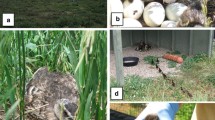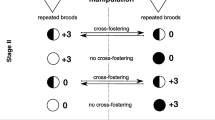Abstract
Vertebrate mothers transmit antibodies to offspring that provide humoral immunity early in life. The duration of protection provided by maternal antibodies varies considerably among species and has not been widely examined in birds. Determination of the length of maternal protection can be a useful predictor of when young are most likely to be susceptible to infection. The duration of maternal antibody protection was determined in Japanese Quail (Coturnix japonica) by immunizing females with keyhole limpet hemocyanin (KLH) and then collecting blood samples from offspring. Maternal antibodies remained detectable in offspring circulation for an average of 14 days (range 3–28). The duration of persistence was predicted by antibody levels as measured in maternal circulation, within egg yolks, or measured in offspring shortly after hatch. Thus, the primary benefit to offspring of high concentrations of maternal antibodies is likely to be an extended period of maternal protection during early growth and development.


Similar content being viewed by others
References
Al-Natour MQ, Ward LA, Saif YM, Stewart-Brown B, Keck LD (2004) Effect of different levels of maternally derived antibodies on protection against infectious bursal disease virus. Avian Dis 48:177–182
Bollen LS, Hau J (1999) Comparison of immunospecific antibody response in young and old chickens immunized with human IgG. Lab Anim 33:71–76
Boulinier T, Staszewski V (2008) Maternal transfer of antibodies: raising immuno-ecology issues. Trends Ecol Evol 23:282–288
Brambell FWR (1970) Transmission of immunity in birds. In: Neuberger A, Tatum EL (eds) The transmission of passive immunity from mother to young, vol 18. Elsevier, New York, pp 20–41
Brommer JE (2004) Immunocompetence and its costs during development: an experimental study in blue tit nestlings. Proc R Soc Lond B 271:S110–S113
Casto JM, Nolan V Jr, Ketterson ED (2001) Steroid hormones and immune function: experimental studies in wild and captive dark-eyed juncos (Junco hyemalis). Am Nat 157:408–420
Demas GE, Chefer V, Talan MI, Nelson RJ (1997) Metabolic costs of mounting an antigen-stimulated immune response in adult and aged C57BL/6J mice. Am J Physiol Regul Integr Comp Physiol 42:R1631–R1637
Gasparini J, McCoy KD, Tveraa T, Boulinier T (2002) Related concentrations of specific immunoglobulins against the Lyme disease agent Borrelia burgdorferi sensu lato in eggs, young and adults of the kittiwake (Rissa tridactyla). Ecol Lett 5:519–524
Gasparini J, McCoy KD, Staszewski V, Haussy C, Boulinier T (2006) Dynamics of anti-Borrelia antibodies in Black-legged Kittiwake (Rissa tridactyla) chicks suggest a maternal educational effect. Can J Zool 84:623–627
Glezen WP (2003) Effect of maternal antibodies on the infant immune response. Vaccine 21:3389–3392
Graczyk TK, Cranfield MR, Shaw ML, Craig LE (1994) Maternal antibodies against Plasmodium spp. in African black-footed penguin (Spheniscus demersus). J Wildl Dis 30:365–371
Grindstaff JL (2008) Maternal antibodies reduce costs of an immune response during development. J Exp Biol 211:654–660
Grindstaff JL, Brodie ED, Ketterson ED (2003) Immune function across generations: integrating mechanism and evolutionary process in maternal antibody transmission. Proc R Soc Lond B 270:2309–2319
Grindstaff JL, Demas GE, Ketterson ED (2005) Diet quality affects egg size and number but does not reduce maternal antibody transmission in Japanese quail Coturnix japonica. J Anim Ecol 74:1051–1058
Grindstaff JL, Hasselquist D, Nilsson JÅ, Sandell M, Smith HG, Stjernman M (2006) Transgenerational priming of immunity: maternal exposure to a bacterial antigen enhances offspring humoral immunity. Proc R Soc Lond Bi 273:2551–2557
Hasselquist D, Nilsson JÅ (2009) Maternal transfer of antibodies in vertebrates: trans-generational effects on offspring immunity. Philos Trans R Soc B 364:51–60
Klasing KC (1997) Interactions between nutrition and infectious disease. In: Calnek BW (ed) Diseases of poultry. Iowa State University Press, Ames, IA, pp 73–80
Klasing KC, Leshchinsky TV (1999) Functions, costs, and benefits of the immune system during development and growth. In: Adams NJ, Slotow RH (eds) 22nd international ornithological congress, BirdLife South Africa, Durban, pp 2817–2835
Klasing KC, Laurin DE, Peng RK, Fry DM (1987) Immunologically mediated growth depression in chicks: influence of feed intake, corticosterone and interleukin-1. J Nutr 117:1629–1637
Linder N, Waintraub I, Smetana Z, Barzilai A, Lubin D, Mendelson E, Sirota L (2000) Placental transfer and decay of varicella-zoster virus antibodies in preterm infants. J Pediatr 137:85–89
Liu SS, Higgins DA (1990) Yolk-sac transmission and post-hatching ontogeny of serum immunoglobulins in the duck (Anas platyrhynchos). Comp Biochem Physiol 97B:637–644
Lung NP, Thompson JP, Kollias GV, Olsen JH, Zdziarski J, Klein PA (1996) Maternal immunoglobulin G antibody transfer and development of immunoglobulin G antibody responses in blue and gold macaw (Ara ararauna) chicks. Am J Vet Res 57:1162–1167
Nicoara C, Zach K, Trachsel D, Germann D, Matter L (1999) Decay of passively acquired maternal antibodies against measles, mumps, and rubella viruses. Clin Diagn Lab Immunol 6:868–871
Reid JM, Arcese P, Keller LF, Hasselquist D (2006) Long-term maternal effect on offspring immune response in song sparrows Melospiza melodia. Biol Lett 2:573–576
Roitt I, Brostoff J, Male D (1998) Immunology, 5th edn. Mosby, London
Rose ME, Orlans E (1981) Immunoglobulins in the egg, embryo, and young chick. Dev Comp Immunol 5:15–20
Sahin O, Luo ND, Huang SX, Zhang QJ (2003) Effect of Campylobacter-specific maternal antibodies on Campylobacter jejuni colonization in young chickens. Appl Environ Microbiol 69:5372–5379
Seto F (1981) Early development of the avian immune system. Poult Sci 60:1981–1995
Smith NC, Wallach M, Miller CMD, Morgenstern R, Braun R, Eckert J (1994) Maternal transmission of immunity to Eimeria maxima: enzyme-linked immunosorbent assay analysis of protective antibodies induced by infection. Infect Immun 62:1348–1357
Soler JJ, de Neve L, Perez-Contreras T, Soler M, Sorci G (2003) Trade-off between immunocompetence and growth in magpies: an experimental study. Proc R Soc Lond B Biol Sci 270:241–248
Solomon JB (1971) Foetal and neonatal immunology. North Holland, Amsterdam
Staszewski V, Gasparini J, McCoy KD, Tveraa T, Boulinier T (2007) Evidence of an interannual effect of maternal immunization on the immune response of juveniles in a long-lived colonial bird. J Anim Ecol 76:1215–1223
Acknowledgments
Funding was provided by National Science Foundation graduate research fellowship, Indiana Academy of Sciences, Center for the Integrative Study of Animal Behavior at Indiana University, and Indiana University Department of Biology. Cathleen Drilling and Brenda Hoover provided invaluable Quail care assistance, Greg Demas generously provided access to ELISA equipment, Rod Suthers provided space for housing Quail, and Ellen Ketterson, Britt Heidinger and Joel McGlothlin provided constructive comments on previous versions of the manuscript. All research was approved by the Indiana University-Bloomington Institutional Animal Care and Use Committee and complied with all federal (United States), state, and local laws.
Author information
Authors and Affiliations
Corresponding author
Additional information
Communicated by C. G. Guglielmo.
Rights and permissions
About this article
Cite this article
Grindstaff, J.L. Initial levels of maternally derived antibodies predict persistence time in offspring circulation. J Ornithol 151, 423–428 (2010). https://doi.org/10.1007/s10336-009-0472-5
Received:
Revised:
Accepted:
Published:
Issue Date:
DOI: https://doi.org/10.1007/s10336-009-0472-5




